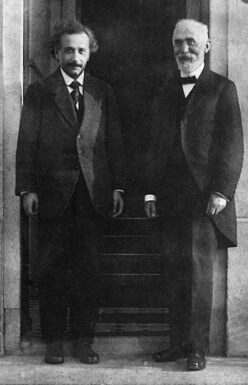τ = F r
- τ torque in Nm
- F force in N
- l lever arm (perpendicular distance from P tot the line of action of F)
If F tends to cause counterclockwise rotation around P then we choose τ > 0
If F tends to cause clockwise rotation around P then τ < 0
Example 1

Torque of F1 with respect to P = F1 l 1= – (3.0)( 0.02) =
– 0.06 Nm (if l 1 in cm then 6.0 Ncm )
Torque of F2 with respect to P = 0.06 Nm
Example 2
An uniform bar of 2.00 m with a weight of 30.0 N is supported in S. The bar can rotate about S in the vertical plane. The center of mass O is in the middle.
OS = 25 cm (see drawing)

The bar is in equilibrium.
a.Find the force on the end A of the bar (FA )
There are two conditions of equilibrium:
1.Σ τ = 0 with respect to every point
2.ΣF = 0 N
The sum of the torques must be zero
Σ τ = 0 with respect to S:
W OS – FA AS = 0
(30.0)( 0.25) – (FA) (0.75) = 0
FA = 10 N
b.Find the force on the bar in S.
The sum of the forces on the bar must be also zero.
FS = W + FA
Example 3
Given a uniform bar. Lenght = 1.00 m. The weight of the bar is 20.0 N
A force of 10.0 N acts perpendicular downward on the bar in A.
The bar is supported in S.
The bar is in equilibrium.
In B, at 40 cm from the center of mass, a force F acts upwards on the bar at an angle of 30 o.

a.Find F.
Resolve F into two directions, along the bar and perpendicular to the bar
Sin 30o = Fy/F Fy = F sin 30o = 0.5 F
cos 30o = Fx/F Fx = F cos 30o = 0.866 F
Sum of the torques is zero
Σ τ = 0 with respect to S
FA AS – Fy BS = 0
(10)( 0.50) – (Fy )( 40)= 0
Fy = 12.5 N
Now we can calculate F
F y = 0.5 F
F = 12.5/0.5 = 25.0 N
b.Find magnitude and direction of the force that acts on the bar in S.
A second condition for equilibrium is
ΣF = 0 N

At first in the vertical direction: FSX = 30.0 – 25.0 = 5.0 N (upward)
In horizontal direction : FSX = F 0.866 FSX = (25 )( 0.866) = 21.65 N (to the left)
Both components of Fs are known:
FS = 22,2 N
( Pythagorean theorem FS2= FSX2 + FSY2)
Calculation of the direction :
tan α = 5.0/21.65 = 0.2309
α = 13 o
